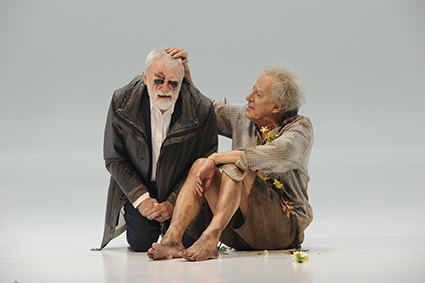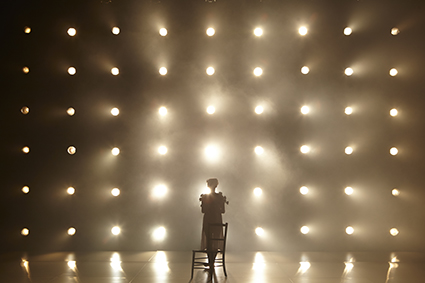Insanity, inside & out
Keith Gallasch: STC, King Lear; Sydney Chamber Opera/Ensemble Offspring, An Index Of Metals

Geoffrey Rush, Max Cullen, King Lear, Sydney Theatre Company
photo Heidrun Löhr
Geoffrey Rush, Max Cullen, King Lear, Sydney Theatre Company
Insanity took centrestage in major productions in Sydney of Shakespeare’s King Lear and Fausto Romitelli’s An Index of Metals. In each the rupturing of a personal relationship yields terrible consequences. In Lear we watch the whole process unfold, in An Index of Metals we enter the mind of a woman living out the aftermath.
STC, King Lear
Geoffrey Rush’s Lear is elegant and stentorian—gravely and boldly voiced without ever being stock ‘Shakespearean’ in his delivery. Chest thrust out, he holds his head high. He’s robust, sweeping about the stage, but easily battered by emotional shocks that propel hand to heart and have him seeking out chairs either side of the stage, caving in, chest sunken, before angrily rallying. The anger is palpably raw but so is the personal pain his old age cannot immure him to. We already sense an emotional complexity that will unleash the madness he already fears and which will ultimately engender his short-lived salvation.
Rush brings to Lear a contemporary gravitas, underlined by the production’s initial setting, its opening scene akin to a party at an upper end reception centre or RSL club, men in dinner suits, women grandly frocked, some aptly kitsch entertainment from the Fool, tinsel and speeches at a microphone. This Lear has the appearance of an elder statesman and indeed looks mightily like Malcolm Fraser in country cap and long coat in scenes that follow. Rush perfectly embodies Lear’s bewildered, mad and sad trajectory right to its dark conclusion, the aged body increasingly weakening, memory fading save for the small jolts of recollection that return him to a tormenting real world. But the journey is critically interrupted and it’s not Rush’s fault.
The first part of Neil Armfield’s production, designed by Robert Cousins, is set in a vast empty black-walled space, filled with machination and misjudgement and only tinsel, microphone and costuming to minimally evoke location. In the second part there’s an edgeless, depthless white space—modulated by mist and subtle pastels—rapidly emptying of life but finally admitting of love and nuance. In between is the storm and Lear’s refuge on the heath. For a production excelling in minimal design that foregrounds action and emotion, the storm scene is astonishingly overwrought—the black walls slide up to partly reveal a white expanse against which we see an enormous volume of heavy rain flooding the stage, while live percussion thunders at the expense of words as Lear runs towards a huge industrial-scale fan to the side of the stage that fiercely pumps wind and mist. What’s lost is our direct contact with Lear, here he’s in profile braving the blast, and, above all, the fine balance between the inner and outer storms, the superfluity of the latter here scuttling the connection. Recovery is quick, but we have been rattled for the wrong reasons. Likewise, some devices that start out well are sustained too long after their framing of the initial scenes—the use of the microphone and the ba-boom drum beats that climax the Fool’s witticisms—instead of letting them fade as mood and circumstances change.
Also out of kilter was Meyne Wyatt’s powerful performance as Edmund, big and loud (and louder with microphone) as if dropping in from a performance of a play by one of Shakespeare’s revenge tragedy peers of the 1590s.
Otherwise performances all round were uniformly strong and subtly modulated, with licence given, of course, to Mark Leonard Winter’s excellent, naked Poor Tom to run mad and slide gleefully across the wet heath. This was a memorable if flawed Lear but the acting, the seamless transitions from scene to scene, the design and lighting (Nick Schlieper), Alice Babidge’s costumes and the live music (John Rodgers with Simon Barker and Phil Slater in a fine take on drums and trumpets), added up to an almost satisfying whole. Perhaps the storm scene will be recalibrated. I hope so. Best of all is Geoffrey Rush’s performance although there are many who have cast him forever as inspired clown and will let him be nothing other, missing what a superbly embodied Lear he has given us.

An Index of Metals, Sydney Chamber Opera
photo Zan Wimberley
An Index of Metals, Sydney Chamber Opera
Sydney Chamber Opera, Ensemble Offspring, An Index of Metals
Director Kip Williams has responded to the late Fausto Romitelli’s An Index of Metals—for instrumental ensemble, electronics and two electric guitars—by creating a scenario for a psychodrama suggested by the work’s fragmentary poetic text from Kenka Lekovich. It’s monumentally framed by three walls and a ceiling of some 200 lights that suggest a surreal padded cell or place of interrogation writ large. They function in enormous waves, reflecting the surging emotional states of a lone woman (soprano Jane Sheldon) attempting to come to grips with the breakdown of her relationship with ‘Brad’ (of Roy Lichenstein’s pop-art masterpiece Drowning Girl: “I don’t care, I’d rather drown than call Brad for help”). The sense of drowning is amplified with descending glides, both gentle and vertiginous, from the orchestra and, grippingly, from Sheldon.
The protagonist’s mental condition is portrayed as neurotic with her compulsively repeated tipping over of a vase of red roses and her chair on an otherwise empty stage until, neurosis turning to psychosis, she conjures a man, clearly the object of her thwarted desire, whom he she undresses and soon multiplies into five more naked men. Counterpointing, and not competing with, Romitelli’s dense, propulsive score and Lekovich’s evocative phrasings (that include the metals of the title: iron, copper, nickel, lithium and rust with their various resonances), Williams wisely keeps stage action spare save for several critical passages. Initially closed in on herself, the woman is hoisted high multiple times on her chair by the men, out of darkness into light, until she gradually opens out, extending a leg, drawing up her dress and leaning exultantly back. It’s a temporary erotic reprieve and prelude to her own nakedness—a profound vulnerability—and suicide (the music painfully and metallically grand). But in a hyperbolic ending the woman is rejoined by the men, equally blood drenched, as if she has exorcised herself of Brad in the very act of self-destruction. The accompanying, deeply melancholic adagio is followed by a final dark enigmatic guitar passage, confirming not only the powerful and often subtle role of the two instruments (Joe Manton, Cat Hope) throughout, but also recalling an intriguing phrase sung earlier by Sheldon in one of her four arias, “murdered by guitar.”
Jane Sheldon’s convincing evocation of advanced nervous breakdown and her sublime singing, Elisabeth Gadsby’s design and Ross Graham’s lighting and the combined instrumental forces of Sydney Chamber Opera and Ensemble Offspring, conducted as ever by Jack Symonds with passion and precision, came together to make an opera of An Index of Metals. Having the orchestra placed immediately before the audience meant that we could luxuriously immerse ourselves in the playing itself as Kip Williams’ direction carefully balanced sound and image. Meanwhile we were surrounded by glorious real time electronics operated by Bob Scott. Although the pulsing of waves of light in which the woman is drowning and the final bloodiness seemed overwrought and at times archly stagey and the movement and demeanour of the men too abstracted, Kip William’s fidelity to Lekovich’s text and his dramatic expansion of it proved to be an admirable venture for all parties involved and another step forward for adventurous opera in a Sydney greedy for it.
Sydney Theatre Company, King Lear, writer William Shakespeare, Sydney Theatre, 28 Nov, 2015-9 Jan, 2016; Carriageworks, Sydney Chamber Opera & Ensemble Offspring: An Index of Metals, Carriageworks, Sydney, 16-19 Nov
RealTime issue #130 Dec-Jan 2015 pg. 37






